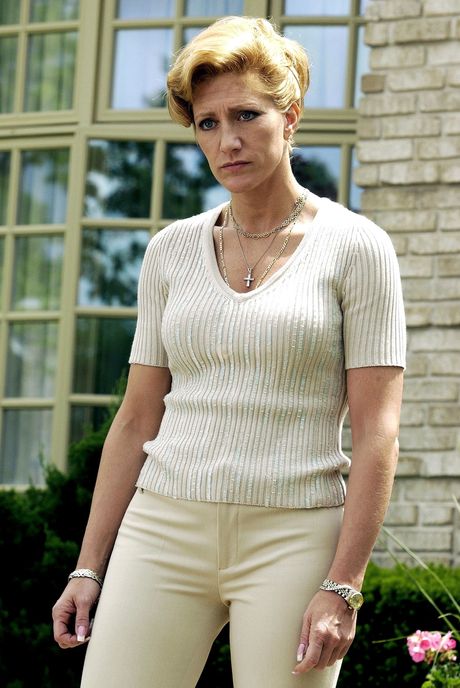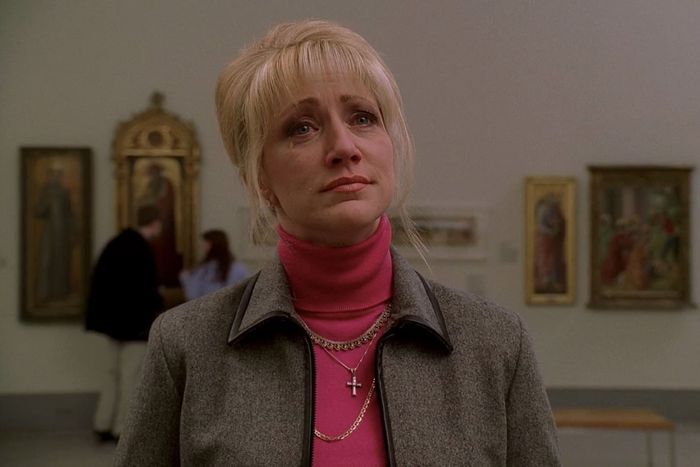
Sometime on the night of Monday, September 4, 2017, at my parents’ apartment in Manhattan, I took advantage of their HBO subscription and watched The Sopranos. I know the exact date because I took a photo of my parents’ TV screen, lit up and high contrast against their dark apartment, of Edie Falco as Carmela Soprano, wearing a snake-print blazer, long-ass fingernails, a huge diamond ring, and an expression of dismay, distrust, or both. I posted it to Instagram. I captioned it “me.”
The week after that, I transitioned. Carmela made me trans.
Well, obviously, it’s more complicated than that. But soon after I watched that episode, I had a nervous breakdown. It was partly related to PTSD, and largely related to realizing I did not want to be a man anymore. I had recognized something in Carmela — not only in her clothes and hair, which reminded me so much of the older women in my life, but in the way she carried her pain. The alternate, possibly better lives she had given up to make her current life work.
At the time, I was an egg, compartmentalized and scared, pretending that the strictures of my life were inevitable, and even somehow morally correct. This is a common trans experience, the assumption that, no, life cannot get better, and yes, you always will be repressed; you “crack” when you realize that you can do whatever the fuck you want (at least within the limits of our transphobic, material reality).
Seeing a woman whose aesthetic I could yearn for, but who was herself emotionally, socially, and sexually repressed, made the prospect of womanhood seem realistic for me. I could not imagine being a woman who was happy and free. But I could imagine being Carmela.
Trans people have existed for eons, but each new trans person made in this world largely has to make themselves. As writer on trans history Morgan M. Page recently pointed out, we are constantly rediscovering the very idea of transness as if it’s the first time, thanks to the erasure of trans history and the impact of institutional transphobia — in prisons, a lack of health care, and societal neglect. This is changing; the bonds of transness between generations are strengthening. Nonetheless, transitioning is still a deeply isolating experience.
To vastly oversimplify it, you start at point A and need to get to point B. At first, the Grand Canyon seems to separate those points. Eventually, you learn to build a bridge to get across. But first you need to have a beacon at point B — lights to guide you on this lonely, scary journey, during which you might lose friends, family, a sense of security, a sense of self.
On September 4, 2017, I was at point A, staring at Edie Falco’s face on my parents’ TV, stunned at the recognition I felt when I looked at her. At first, I thought it might just have been because of the character’s styling — the animal-print tops, the long fingernails, the blonde hair, the jewelry. The Sex and the City women had been gaudy too, in their own way, wearing expensive statement dresses and impractical heels. But Carrie did not feel like a point B to me. Carmela did.
Falco has said that the elements of Carmela’s look weren’t accoutrements, but integral parts of the process of becoming Carmela — so powerful that they pushed her into being a different person. “If my father was to put on the fingernails and the hair, he would end up becoming Carmela as well,” Falco said in an interview. Falco felt the role was entirely out of her wheelhouse: “Not being a real girly girl in that way, it was very fun” to play her.
I grew up in New York City. My mom is from New Jersey. We’re Jewish, not Italian, and my parents were not in the mob (as far as I know), but many of the women in my life looked like Carmela. She is, to me, the ultimate example of a kind of vaguely ethnic white womanhood. What might look gaudy to some to me just looks like my grandmas: my dad’s mom in her sequin tops and big hoop earrings, my mom’s mom in the fur coats she wore for her daily walks through lower Manhattan.
Carmela, like both my grandmas, had pride in the stoicism she exhibited as she carried her pain. She had a deep sense of obligation to her family even as she yearned for more, and she, like my grandmas, found joy where she could — in her clothes and style, in her ability to bring family together around a table, in her conviction that if she kept going, at least her children’s lives would be a bit better than hers. Yet she also spends all six seasons of The Sopranos trapped in a cycle of complicity and victimhood, benefiting from her husband Tony’s crimes even as she bemoans them. There is much that is not unique about Carmela; she is one of countless representations of repressed and complicit women in movies, TV, fiction (see: Skyler White, Anna Gunn’s character in Breaking Bad). But Carmela’s repression felt closest to mine, felt closest to that of my family members.
Carmela is a woman trapped in her circumstances — if she leaves Tony she will lose money, her friends, her lifestyle, her family — but she is mostly trapped in a cage of her own psyche, constantly battling her own expectations of herself, her desire to raise a family and provide for them, and her desire to feel an individual freedom made impossible by those things. The character spends much of her time lamenting how much she’s let happen, confessing to priests, a psychiatrist, her friends about her complicity. She spends the rest of her time offloading her life choices onto others, blaming her kids, Tony, her mom, everyone, for her predicament. When people tell her to allow herself peace, she chastises herself for how bad she is. “I have forsaken what is right for what is easy,” she tells a priest early in the first season. “Allowing what I know is evil in my house. Allowing my sweet children to be a part of it. Because I wanted a better life for them. Because I wanted this house. I wanted money in my hands.”
When, midway through season three, a psychiatrist tells her she’ll never feel happy unless she leaves her husband, she willfully misunderstands him over and over again, softening his words, telling herself that she needs to set boundaries and internalize less conflict, and ignoring the doctor’s blunt warning. Carmela may be a mob boss’s wife, but she also is the embodiment of a womanhood that many, cis and trans, yearn for, against their better instincts: one that replicates the infantilized yet secure state of the suburban housewife, where we can be both victim and perpetrator, but mostly have our agency taken away from us.
Writer Jamie Hood elucidated this conundrum through the story of another of TV’s notorious-yet-loved matriarchs, Betty Draper, in an essay for the New Inquiry. “Isn’t this the Betty Draper problem writ large?” Hood asks. “Longing for the lobotomization of the Stepford Wife yet trapped in the trauma of being?” Feminism has not completely liberated us — we may work alongside men and lead lives independent of them, but we still feel unsatisfied, a certain true liberation (economic, social, sexual) missing from life. We can see that contradiction in the music of Lana Del Rey, and in the tradwife aesthetic. It could be the Betty Draper problem, or the Carmela Soprano problem, or the P.E. Moskowitz problem: It is very normal as a white woman to yearn for the security of white, patriarchal oppression, even as you recognize your complicity in it, and the limits it forces upon you.
We’re drawn to Carmela and women like her because they allow us to play out a fantasy that we know we need to leave behind.
When I called Carmela “me” back in 2017, that’s what I was yearning for: to become a white woman, with all the fun and all the fucked-up shit that entails. I wanted the girlboss attitude. I wanted to strut confidently down the street in designer clothing and have people recognize my power. I wanted the oppression and the complicity. I wanted the whole package.
But when I rewatched The Sopranos recently, I felt a new distance from Carmela. I am a trans person in 2021, a committed anticapitalist, someone who believes in gender liberation. I know that just because white trans women must make a more concerted effort to be perceived as women, that does not erase our ability to oppress others. I still felt pangs of recognition as I watched Carmela glide around her Jersey mansion — her desire for glamour, her insistence on the importance of family above all else — but now I felt a need to move beyond her, and beyond the false choices presented to women like her, and women like my grandmothers.
The most haunting scene for me in The Sopranos is late in the third season, when Carmela visits a museum with her daughter, Meadow. They pass a painting of Jusepe de Ribera’s The Holy Family With Saints Anne and Catherine of Alexandria, and Carmela begins to cry. “Look at the little baby’s hand against her cheek,” she says. “She’s so at peace. Beautiful, innocent, gorgeous little baby.” Carmela so yearns for this innocence, to be uncorrupted, to be given back a kind of moral virginity — to lift off all the compromises she’s made to feel comfortable, afford the clothes she wants, and give her kids the lives she feels they deserve. She wants out.
But Carmela stays. She retreats into her corrupt comfort.
At one point, when I felt no agency over my own gender and thus little agency over my own life, I might have found this scene moving and sad. Now I find it kind of sick. She has the choice to stop yearning for something so impossible, and over and over again chooses to keep yearning. I know I don’t have to do that. I can leave. I can move on, past the beacon at point B to something better. I may not necessarily be happier, but I can be more fulfilled, more complete, less complicit in all the moral compromises women like Carmela felt they had to make.
Yet I recognize that the first thing I did when I was assigned this piece was to calculate how much of my check I could spend on a flashy designer coat. I wrote it while wearing a leopard-print top. There are still a few things Carmela got right.



